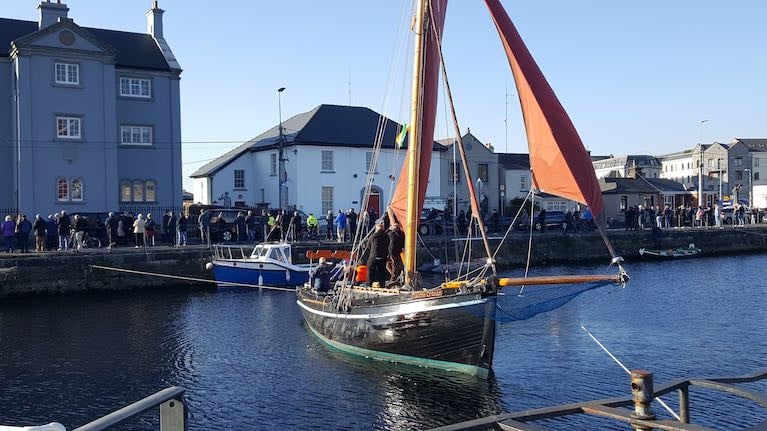When the funeral of Galway fishermen Martin and Tom Oliver left Claddagh church yesterday, the silence among hundreds of people lining the route was broken only by the roar of the river Corrib and the gentle sound of wind in canvas sails.
Three Galway Hookers had moored in the Claddagh Basin, with musician Sharon Shannon on board the deck of one of the vessels playing soft airs on her accordion.
 Three Galway Hookers moored in the Claddagh Basin
Three Galway Hookers moored in the Claddagh Basin
Martin, who was almost 62, and his son Tom (37) died within 24 hours of each other after a fishing accident on their potting vessel on the north side of Galway Bay last Monday.
Mayor of Galway Mike Cubbard, who opened a book of online condolences, paid tribute to the two men as “salt of the earth” and “the best of friends”.
He noted that it was only a few weeks since he had recognised the role of Martin’s relatives, Patrick and Morgan Oliver, in rescuing two paddleboarders, Sara Feeney and Ellen Glynn, in Galway Bay last August after 15 hours at sea.
Several generations of the Oliver family have been associated with the lifeboat service, and members of the RNLI and the fishing communities along the coast and on the Aran islands travelled to pay their respects.
Galway RNLI volunteers and members of the Galway Sea Scouts formed a guard of honour outside the church, where a private Mass was celebrated by Fr Gerry Jennings of Salthill parish, assisted by Fr Donal Sweeney of the Claddagh’s Dominican community.
Afterwards, Martin’s daughter and Tom’s sister Susanne and her mother Eileen were consoled by many friends, and relatives, as the city centre came to a standstill and construction work stopped as a mark of respect.
Crew with Badóirí an Cladaigh and the Galway Hooker Sailing Club had rigged the gleoiteog Manuela - named after the late Swiss student Manuela Riedo - along with the leath-bhád Croi an Cladaigh, and the bád mór Naomh Crónán in full sail in the Claddagh basin.
A Garda escort led the cortege over Wolfe Tone bridge and around by Long Walk and into Galway docks, as people lined both sides of the streets.
Two orange flares were released on the water surface, and members of Galway Bay Sailing Club then lit hand-held flares on the dockside, where State research ship Celtic Voyager and a number of fishing and angling vessels were berthed.
 Flares were lit and harpist Úna Ní Fhlannagáin (left) played at Galway Docks
Flares were lit and harpist Úna Ní Fhlannagáin (left) played at Galway Docks
The rich chords of harpist Úna Ní Fhlannagáin resonated as members of the Oliver and Griffin families cast flowers at the water’s edge in bright sunshine.
The cortege paused for a few moments at the docks, and more tears were shed before the two hearses continued up to Rahoon cemetery overlooking the city. In the graveyard, the father and son – who had been inseparable in life - were buried side by side.
Galway harbourmaster Brian Sheridan said it was a “profoundly sorrowful tragedy for the Oliver family, and the wider fishing community”.






























































